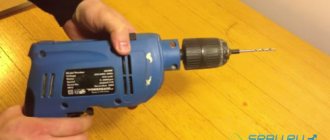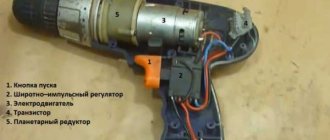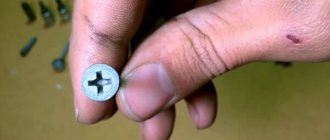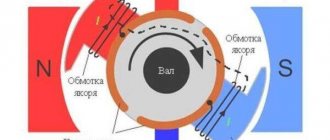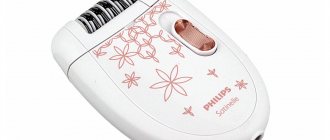Typically, a drill is used to drill holes in a variety of materials - it can be wood, plastic and even metal. There are also grinding and cutting attachments for this tool.
There are several types of drills:
- Manual;
- Pneumatic;
- Electrical.
The principle of operation of the tool is to transmit rotation to a drill or other attachment, due to which it is possible to carry out various types of work - construction, plumbing, finishing, etc. “If I use a drill for such a large number of tasks, can I find other uses for it? » - this is probably what many people might think. And the answer is yes, you can expand the list of jobs for this tool and add to it the screwing of screws.
Comparisons between screwdriver and drill
To begin with, it is worth understanding the distinctive features of these instruments, because although they both perform a rotational movement, their purposes are different.
The most important difference is the rotation speed of the working spindle - the rotation of a screwdriver is much slower than that of a drill. Also, it has no inertia - the tool stops at the same time when the mechanism is turned off. The spindle, when drilling, continues to rotate for some time after switching off.
A drill is a potentially more dangerous tool than a screwdriver, therefore, when working with it, special safety precautions must be observed - safety glasses, in addition to the usual attentiveness, accuracy and caution.
The choice of operating mode is another difference between the instruments under consideration. In addition to the main one, a drill also has an impact mode, while a screwdriver is regulated only by the spindle speed.
As can be seen from the comparison, the drill is less suitable for working with screws and bolts, however, it can be adapted for this task.
How to use a drill as a screwdriver?
First of all, you need to select the appropriate tool model for your purposes and the type of screws/bolts - bits. They should be installed in place of the drill in the spindle chuck.
Further, if possible, it is recommended to reduce the rotational speed of the mechanism - this will make the work safer, as well as keep the tool and attachments in working condition - at low speeds they wear out less. Some models have speed controllers, while others can be adjusted manually by changing the mechanism or electrical circuit.
For experienced craftsmen, it will not be a serious problem to work with a drill as a screwdriver and at high speeds, but there is always a risk of damaging the bit or screw, cutting off the screw head, “screwing” the material through, etc.
It is also worth considering that drilling tools do not have a splitting clutch (it is responsible for preventing damage to the tool mechanism when the engine suddenly stops), so the necessary work should be carried out carefully. It is recommended to use stronger attachments than for a screwdriver.
Work principles
You should always keep in mind that you are going to use the tool for purposes other than its intended purpose, and this comes with some difficulties and limitations.
Basic rules for safe and efficient use of a drill as a screwdriver:
- Follow safety requirements. Handle the tool with care.
- Do not tighten the screws all the way - this can lead to breakage of the tool, bit, or object being screwed. Experienced craftsmen advise to under-tighten the screws a little, and then finish them manually using a screwdriver.
- To securely attach the bit, it is recommended to use extended bits or a specialized bit holder.
- For wooden material, to avoid splitting the wood, it is recommended to first drill holes and only then tighten the screws.
Of course, it is better to use a screwdriver for such purposes, but a drill can also cope with these types of work.
Can You Use an Impact Drill as a Screwdriver?
Content
What is the difference between a drill and a hammer drill, and a screwdriver and which is better to choose?
The question, what is the difference between a drill and a hammer drill , is asked by young craftsmen. Although, it immediately seems that these tools are similar, that they are both created for creating different holes. But the difference between them is significant, because before you go shopping for them, it is important to find out what, for what purpose, this or that “relative” is used.
The difference between a hammer drill and a drill and the main properties of the tools
The main purpose of a hammer drill is to drill holes in materials with high density. Such materials include:
- Artificial stone;
- natural stone;
- concrete;
- brick.
A drill is used to drill into wood, metal, or, in other words, foam concrete. Without going into details of the mechanism of operation of a hammer drill or a drill, we can say that a hammer drill makes holes using impact, and a drill uses a means of rotation.
What then is the main feature of a hammer drill from an impact drill? The impact mode of the drill does not work without the help of others, but is an addition to rotation. Sometimes they occur when the tool is switched to myth mode, the drill does not stop spinning, but begins to not hit yet. But the “power” of the tool is only enough for bricks (in general, not every time), and it will be almost impossible to drill concrete with it. In general, using an impact drill for such work is an option very rarely, since constant operation in this mode leads to breakage of the ratchet. Already, drilling in dense materials requires enormous effort.
READ What is an Impact Driver for?
There are hammer drills that have an additional drilling mode. But it is often not recommended to make holes in soft materials using them. That's all, this will quickly lead to wear of the gear shaft , in this case the tool will need to be repaired, and the holes will not be so careful.
Also, the difference between a drill and a hammer drill is the power consumption. As unusual as it may seem at first, the perforator has an even lower oil content, which means it wastes less electricity. For example, on a hammer drill operating without working in drilling mode and without operating in impact mode, the power indicated is 400 W. This means that in an hour of operation it will “eat up” 0.4 kW. For a similar impact drill, this figure will be about 1000 W, then naturally, in an hour, similar to oil, it will consume 1 kW.
Drill or screwdriver, what to choose
Often you don't know what's best. So I decided to look into this issue.
Rotary hammer and impact drill: do they replace each other?
Drill
can work with impact, like a hammer drill, the same can work simply in
drill
, without impact. That
By and large, a drill is a more multifunctional tool than a hammer drill. Different attachments can turn it into not a construction mixer, not a nibbler, and not even a pump. Most of these functions are difficult for a hammer drill to access. There are various adapters on sale, but their price is even higher than their counterparts designed for drills. But the hammer drill itself is even more capricious in this regard - often using it for purposes other than its intended purpose leads to rapid breakdown of the tool.
READ Professional Wood Sanders
What is the difference between a drill and a screwdriver, and how can this difference be used?
This question is often asked to consultants in construction stores. Unlike a drill, a screwdriver is designed to tighten fasteners. The screwdriver has a special release clutch, with which you can adjust the force created when tightening. This allows you to keep the slot on the head of the hardware intact and undamaged, and also to tighten it gradually, without “driving” it into the material. The force must be selected experimentally depending on the size of the screw. It is worth noting that this tool is not intended for drilling holes.
There are also drill-drivers on sale that can work in both modes. They are heavier than fastener-only models and cost more. However, their scope of application is much wider
than simple screwdrivers, which means this purchase is more suitable for the home.
It is certainly possible to use a drill without a screwdriver function to tighten fasteners, but it is not recommended. The fact is that even the smoothest movement of this tool is not capable of providing the correct force during operation. In practice, this means that the slots on both the fastener head and the nozzle itself will most likely be torn off and it will be impossible to unscrew the screw if necessary.
The age-old question: which is better - a drill or a hammer drill?
In fact, this question is not very correct. In this case, we are not talking about “better” or “worse”, but about the expediency of such a purchase. Let's say, if you are purchasing a tool for your home, then buying a hammer drill (considering its high price compared to a drill) will not pay off soon, because you are unlikely to drill and tap concrete very often. However, if you are faced with a serious repair, in which you definitely cannot do without such work, a hammer drill will come in very handy. It is possible to drill a few holes in concrete with an impact drill, but making a significant number of them is not recommended. It is worth remembering that in some cases, repairs can be even more expensive than purchasing a new drill.
READ Which Screwdriver is Better Makita Or Bosch
If the main part of the work for which the tool is intended is drilling plastic, wood and metal, then a regular drill will do just fine. But even in this case, it is best to purchase a model with a shock function - the price difference is small, and the scope is much wider. However, over time it will be possible to add a hammer drill to your “arsenal” - in brick and panel houses it will definitely not be superfluous.
Pros and cons of using a drill as a screwdriver
Despite the rather forced use of the tool in an area unusual for it, this solution also has some advantages:
- Thanks to an a priori higher number of revolutions and increased speed, the drill copes with the tasks faster than a screwdriver;
- Due to the greater force, it is possible to screw screws into harder and more rigid materials (some metals, etc.);
- The ability to use one tool for a whole range of diverse jobs.
There are also disadvantages:
- Drills, as a rule, are heavier and bulkier - it is not always possible to get into hard-to-reach places;
- Using them as a screwdriver requires some skill;
- The drill is not suitable for thin and fragile materials (plastic, drywall, boards less than 20 mm, etc.), as well as furniture;
- Special safety precautions are required - safety glasses, not tightening screws, avoiding impacts during work, etc.;
- Great wear of the tool (bits and attachments), as well as a significant risk of damage to the screws.
We can conclude that the drill can occasionally be used as a screwdriver, but you should not abuse it for such inappropriate use.
How to make a powered screwdriver
A powered screwdriver is the dream of many home craftsmen. In principle, it happens that in a home workshop there is no need for a cordless tool. You can have access to an outlet at any time. Of course, having a cordless screwdriver in your hands is convenient. But when working, you also hold in your hands, in addition to the tool itself, a battery. And it will be harder.
Also, batteries often get damaged and break. And since you are unlikely to buy a battery separately from a screwdriver on sale, you will have to puzzle over how you can provide your screwdriver with the necessary power from an outlet, bypassing battery devices.
Advantages of cordless screwdrivers
Cordless screwdrivers are very convenient at construction sites - it’s very easy to work with them on the roof, in difficult conditions, where trailing wires will only get in the way and create unnecessary danger. But this is where battery failure most often occurs - the screwdriver fell, the battery broke, and you will have to look for a new one.
Let's figure out how to make a powered screwdriver.
Replacing a screwdriver with a conventional drill
The easiest option is to use a regular small drill as a screwdriver. You just take the bit and clamp it into the chuck instead of the drill. Working with a drill as a screwdriver will require some skill. The fact is that the drill does not have a “ratchet” - in a screwdriver, the ratchet will work as a fuse when the fasteners are tightened. Therefore, you need to clearly feel this moment and release the button. Otherwise, broken screw heads, damaged bits and bad mood are guaranteed. Another difference between a drill and a screwdriver is the rotation speed.
If the torque in a drill is small and the rotation speed is high, then the opposite is true with a screwdriver. Some even have the ability to adjust the rotation speed. Without a high torque, it is unlikely that you will be able to tighten a large self-tapping screw - you will have to resort to using a screwdriver. Therefore, small screws are usually tightened with a drill.
It is not recommended to use a hammer drill as a screwdriver, although its operating parameters of torque and rotation are more acceptable. The hammer drill has a large radial runout, making it difficult to tighten screws with its help.
Just a corded screwdriver
The second option is to purchase a corded screwdriver at the store. They come in several types. The first, cheapest ones are the same electric drill with a ratchet installed on it. They are not positioned as a professional tool, and can only be used to tighten small fasteners. However, having a ratchet will save the screw heads, your bits and your nerves.
A more expensive screwdriver is a specialized network one. Such a tool has a built-in gearbox, most often of the planetary type.
They are positioned as a professional tool, and are much more expensive.
Often such screwdrivers have the ability to tighten large nuts, bolts, and have a magazine for small screws. This option is the best, although the most expensive.
Converting a cordless screwdriver to a corded one with your own hands
The third option is to convert the cordless screwdriver to work on mains power. You will need knowledge of electronics and circuit design, so it's not for everyone. In addition, you will need to know the operating parameters of your battery.
If the battery is broken, you can ask people on DIY forums to measure the current and voltage parameters of the battery. This will help you make a network power supply. In principle, if you have good knowledge of electronics, you can simply disassemble the battery. Its design will contain chemical batteries connected in a certain way. Knowing their type, from the name of the battery, as well as the connection diagram, you can quickly estimate the battery parameters. And then assemble a rectifier with the necessary operating parameters. Or even replace the elements in a failed battery. And then you won’t have to assemble the rectifier.
Video on battery repair and conversion
This is about repairs:
This is about changing the battery type:
This is about converting to a network model:
hochu-stroitsya.ru
